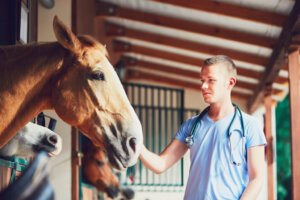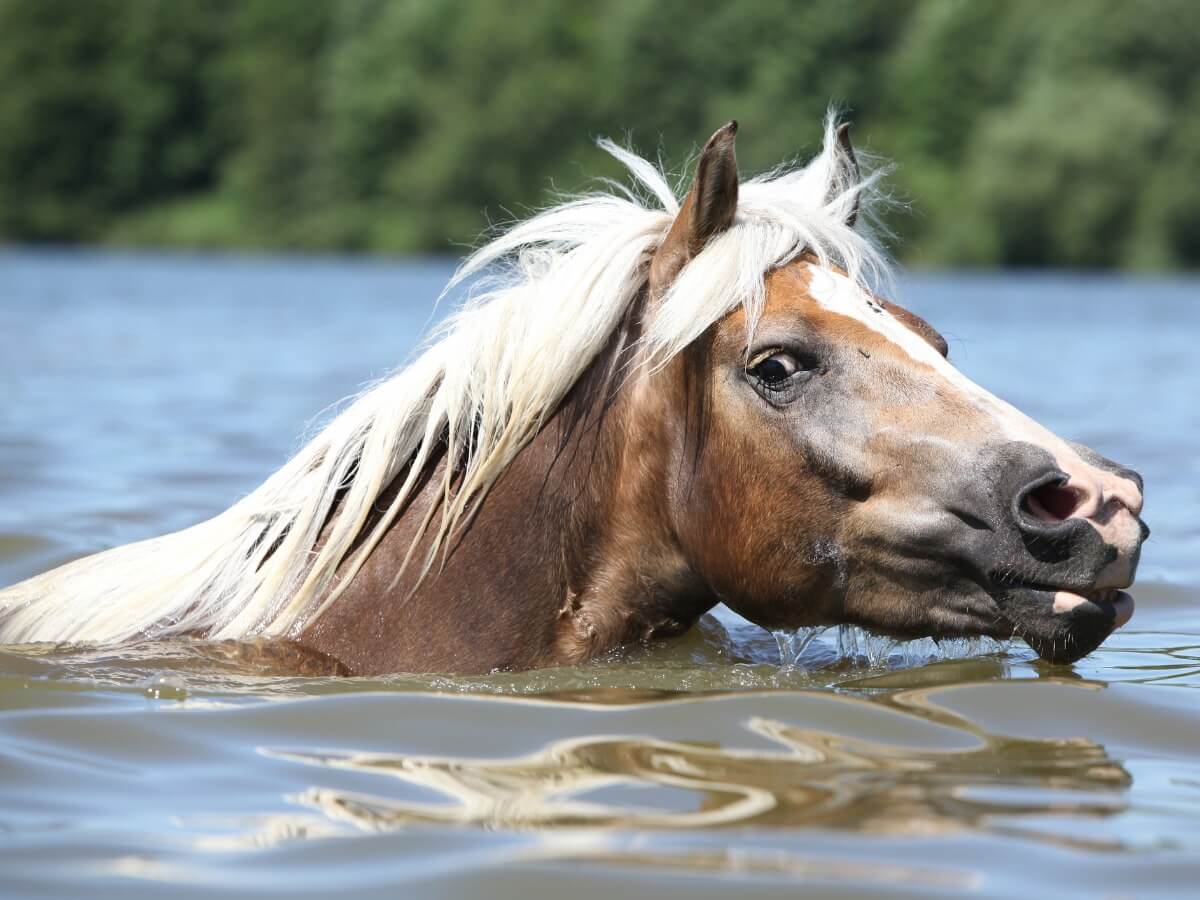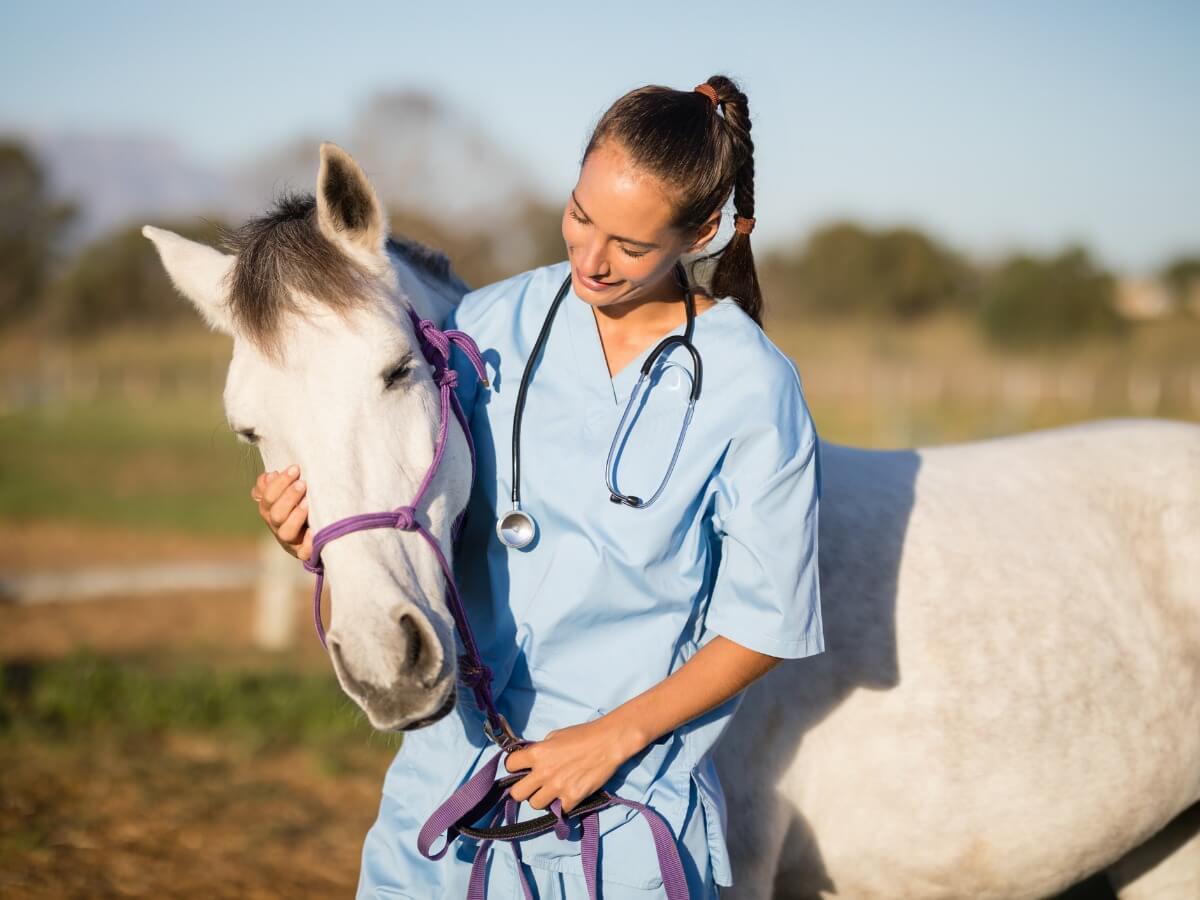What Is Equine Pythiosis?


Written and verified by the biologist Samuel Sanchez
Equine pythiosis is a localized mycosis, characterized by the appearance of cutaneous, subcutaneous, gastrointestinal and multisystemic granulomatous lesions. These are caused by the eukaryotic microorganism Pythium insidiosum. This condition is also known as swamp cancer, as the outbreaks appear mainly in humid regions or after floods.
Pythiosis isn’t unique to horses, as it can also affect plants, dogs, birds, and, occasionally, humans. If you want to know all about this serious condition in horses and how to detect it before it’s too late, read on.
What is equine pythiosis?
Equine pythiosis is a non-contagious condition caused by the pathogen Pythium insidiosum. This is a eukaryotic microorganism belonging to the Pythiaceae family, the Peronosporales order and the Oomycetes class. The mycelium of this species comprises septate hyphae that form sporangia in water and on plant tissues that it parasitizes.
Until recently, experts only considered this disease problematic in wet and swampy regions. However, there have been cases in places that don’t meet these characteristics. For example, in dry areas of the United States such as Illinois, New York and even Wisconsin, symptoms of equine pythiosis have been described sporadically.
We can summarise the pathological mechanism of this oomycete in the following points:
- In the aquatic environment, the hyphae of this microorganism release biflagellate zoospores capable of moving and swimming. These zoospores seek to encyst in damaged tissues, be they animals or plants.
- In the case of horses, the infection occurs by contact and develops in the skin tissue. In dogs, the infection occurs by ingestion of zoospores and the clinical symptoms are gastrointestinal.
- Horses, dogs, cats, cattle, plants, birds, and humans are potential hosts for this oomycete. However, pythiosis is more common in species and large breeds that are often in contact with fresh water.
High temperatures, a lot of vegetation, and water encourage the growth of these pathogenic microorganisms.

Symptoms of equine pythiosis
As indicated by the AG Center professional center, equine pythiosis initially appears as a wound that doesn’t heal. This lesion is an excellent entry point for the pathogen and the site of infection. Once Pythium has colonized the tissue, the area becomes granulomatous. The necrotized cells are stored in it, giving rise to structures known as kunkers.
These lesions occur uniquely on the legs or abdomen of the horse. If the specimen develops more than one granuloma, they all appear in the same place. This will thus give the wound the appearance of a tumor with many growth nuclei. The area smells very bad, has a hard center and produces serous and bloody discharges continuously.
Lesions develop as tumor-like masses — especially on the extremities — which can lead to confusion. This condition is fatal in more than 95% of cases if it isn’t treated immediately.
Is equine pythiosis a type of cancer?
Although granulomatous lesions resemble a cancerous tumor, it should be noted that they actually have little to do with cancer. In malignant neoplasms, a cell line mutates at a genetic level and grows uncontrollably, and can also spread to other tissues in a process known as metastasis.
In equine pythiosis, necrotized lesions take on a swollen form, but they don’t follow the same mechanisms of cancer development and don’t spread to other parts of the body. Therefore, the term swamp cancer isn’t really well used.
Diagnosis and treatment
The diagnosis is made by observing and obtaining samples from the lesion, which will be analyzed to find the exact pathogen. In these cases, the Polymerase Chain Reaction (PCR) is very useful, in which the genome of the microorganism is amplified and its presence is confirmed with specific tests.
Although the diagnosis is relatively straightforward, treatment is another matter. Pythium insidiosum looks like a fungus but it isn’t, so the vast majority of antifungals are useless when it comes to treating the condition. The equine pythiosis approach is done through immunotherapy with something similar to a vaccine, but this cannot be administered preventively.
The immunotherapeutic vaccine prevents the allergic reaction caused by the microorganism, which reduces the risk of death. As indicated by veterinary sources, this complex solution is marketed under the name Pithium Vac®.
Subcutaneous injections
Subcutaneous injections are given on days 1, 7, and 21 of the treatment. The horse must be rechecked at 28 days, and if the condition is still present, another full round of vaccination must be applied. The first versions of this vaccine reported 100% effectiveness in acute cases, but were much less effective in chronic ones.
Today, the new variants of the drug are very effective in acute conditions and cure 50% of chronic patients. The total effectiveness rate is 75%.

Equine pythiosis is a condition that becomes serious and fatal in almost 100% of cases if it isn’t treated in time. Fortunately, vaccines developed since the 1980s have given very good results, and today the general prognosis for infected horses is positive. Faced with an injury of this type in a horse, an urgent visit to the vet is essential.
Equine pythiosis is a localized mycosis, characterized by the appearance of cutaneous, subcutaneous, gastrointestinal and multisystemic granulomatous lesions. These are caused by the eukaryotic microorganism Pythium insidiosum. This condition is also known as swamp cancer, as the outbreaks appear mainly in humid regions or after floods.
Pythiosis isn’t unique to horses, as it can also affect plants, dogs, birds, and, occasionally, humans. If you want to know all about this serious condition in horses and how to detect it before it’s too late, read on.
What is equine pythiosis?
Equine pythiosis is a non-contagious condition caused by the pathogen Pythium insidiosum. This is a eukaryotic microorganism belonging to the Pythiaceae family, the Peronosporales order and the Oomycetes class. The mycelium of this species comprises septate hyphae that form sporangia in water and on plant tissues that it parasitizes.
Until recently, experts only considered this disease problematic in wet and swampy regions. However, there have been cases in places that don’t meet these characteristics. For example, in dry areas of the United States such as Illinois, New York and even Wisconsin, symptoms of equine pythiosis have been described sporadically.
We can summarise the pathological mechanism of this oomycete in the following points:
- In the aquatic environment, the hyphae of this microorganism release biflagellate zoospores capable of moving and swimming. These zoospores seek to encyst in damaged tissues, be they animals or plants.
- In the case of horses, the infection occurs by contact and develops in the skin tissue. In dogs, the infection occurs by ingestion of zoospores and the clinical symptoms are gastrointestinal.
- Horses, dogs, cats, cattle, plants, birds, and humans are potential hosts for this oomycete. However, pythiosis is more common in species and large breeds that are often in contact with fresh water.
High temperatures, a lot of vegetation, and water encourage the growth of these pathogenic microorganisms.

Symptoms of equine pythiosis
As indicated by the AG Center professional center, equine pythiosis initially appears as a wound that doesn’t heal. This lesion is an excellent entry point for the pathogen and the site of infection. Once Pythium has colonized the tissue, the area becomes granulomatous. The necrotized cells are stored in it, giving rise to structures known as kunkers.
These lesions occur uniquely on the legs or abdomen of the horse. If the specimen develops more than one granuloma, they all appear in the same place. This will thus give the wound the appearance of a tumor with many growth nuclei. The area smells very bad, has a hard center and produces serous and bloody discharges continuously.
Lesions develop as tumor-like masses — especially on the extremities — which can lead to confusion. This condition is fatal in more than 95% of cases if it isn’t treated immediately.
Is equine pythiosis a type of cancer?
Although granulomatous lesions resemble a cancerous tumor, it should be noted that they actually have little to do with cancer. In malignant neoplasms, a cell line mutates at a genetic level and grows uncontrollably, and can also spread to other tissues in a process known as metastasis.
In equine pythiosis, necrotized lesions take on a swollen form, but they don’t follow the same mechanisms of cancer development and don’t spread to other parts of the body. Therefore, the term swamp cancer isn’t really well used.
Diagnosis and treatment
The diagnosis is made by observing and obtaining samples from the lesion, which will be analyzed to find the exact pathogen. In these cases, the Polymerase Chain Reaction (PCR) is very useful, in which the genome of the microorganism is amplified and its presence is confirmed with specific tests.
Although the diagnosis is relatively straightforward, treatment is another matter. Pythium insidiosum looks like a fungus but it isn’t, so the vast majority of antifungals are useless when it comes to treating the condition. The equine pythiosis approach is done through immunotherapy with something similar to a vaccine, but this cannot be administered preventively.
The immunotherapeutic vaccine prevents the allergic reaction caused by the microorganism, which reduces the risk of death. As indicated by veterinary sources, this complex solution is marketed under the name Pithium Vac®.
Subcutaneous injections
Subcutaneous injections are given on days 1, 7, and 21 of the treatment. The horse must be rechecked at 28 days, and if the condition is still present, another full round of vaccination must be applied. The first versions of this vaccine reported 100% effectiveness in acute cases, but were much less effective in chronic ones.
Today, the new variants of the drug are very effective in acute conditions and cure 50% of chronic patients. The total effectiveness rate is 75%.

Equine pythiosis is a condition that becomes serious and fatal in almost 100% of cases if it isn’t treated in time. Fortunately, vaccines developed since the 1980s have given very good results, and today the general prognosis for infected horses is positive. Faced with an injury of this type in a horse, an urgent visit to the vet is essential.
All cited sources were thoroughly reviewed by our team to ensure their quality, reliability, currency, and validity. The bibliography of this article was considered reliable and of academic or scientific accuracy.
- Becegatto, D. B., Zanutto, M. D. S., Cardoso, M. J. L., & Sampaio, A. D. A. (2017). Equine phytiosis: literature review. Arquivos de Ciências Veterinárias e Zoologia da UNIPAR, 20(2), 87-92.
- Carvalho, A. D. M., de Galiza, G. J. N., Toma, H. S., de Camargo, L. M., Munhoz, T. C. P., & Kommers, G. D. (2016). Treatment of phytiosis in gestation mare using intravenous regional perfusion of amphotericin B and dimethyl sulfoxide. Revista Brasileira de Ciência Veterinária, 23(1/2), 28-31.
- Miller, R. I. (1983). Investigations into the biology of three ‘phycomycotic’agents pathogenic for horses in Australia. Mycopathologia, 81(1), 23-28.
- Pires, L., Bosco, S. D. M., da Silva Junior, N. F., & Kurachi, C. (2013). Photodynamic therapy for pythiosis. Veterinary dermatology, 24(1), 130-e30.
- Javier, E., Rosas, D., Alfonso, D., & Maldonado Arango MD MSc, M. I. Mycoses for Pythium insidiosum. First case with definitive diagnosis in Colombia.
This text is provided for informational purposes only and does not replace consultation with a professional. If in doubt, consult your specialist.








